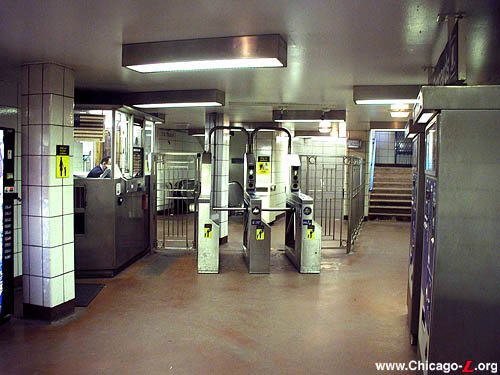
Compared to opening day
(seen below), Clinton station has not changed a great deal,
save for more modern turnstiles and the additional of
several types of vending machines. This view looks west at
the fare controls from the unpaid area of the mezzanine on
December 7, 2001. For a larger view, click here.
(Photo by Graham
Garfield)
|
Clinton
(540W/500S)
Clinton Street and
Congress Parkway, West Loop (Near West Side)
Service
Notes:

|
Blue Line:
Milwaukee-Dearborn Subway
|

|
Transfer to
Amtrak
|
|
|
Transfer to
Metra:
|
Milwaukee
District North and West Lines
North Central Service
Burlington Northern Santa Fe Line
Heritage Corridor Line
Southwest Service
|

|
Owl
Service
|
|
Quick Facts:
Address: 426 S. Clinton
Street
Established: June 22, 1958
Original Line: Milwaukee-Dearborn Subway
Previous Names: none
|
Skip-Stop Type:
|

|
Station
|
Rebuilt: n/a
Status: In Use
History:
While Clinton station is the first station (or last, depending on
one's directional of travel) in the Milwaukee-Dearborn Subway, it's
actually contains a somewhat interesting amalgamation of details and
finishes, owing to the fact that it was not built at the same time as
the rest of the stations on that subway line.
When the Milwaukee-Dearborn Subway opened in 1951, it was fed only
from the north end and terminated at LaSalle/Congress,
one stop to the east. It was always intended to continue the subway
west from there, but what form that extension would take changed a
bit over time. When the Dearborn Subway was first planned in the
1930s, the continuation toward the West Side was visualized to be a
cut-and-dry continuation of the same type of subway going westward,
replacing the Garfield Park elevated. However, by the time the subway
opened in the 1950s, those plans had been modified to place the
extension in the median of the new Congress Street Superhighway, one
of Chicago's first major limited-access expressway projects. Thus,
the subway extension would be short, only long enough to bring the
line to the expressway, at which point the line would ascend to the
surface and continue westward in the median.
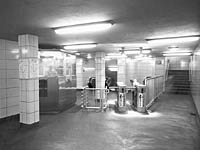
Looking west at the fare
controls in the mezzanine in 1958 not long after opening,
this view shows what Clinton looked like as-built. Note the
posters taped to the column that explain the new
West-Northwest Route service. For a larger view, click
here.
(Photo from the CTA
Collection)
|
Clinton was the only station built in this three-quarter mile
subway, so it was alone among the other stations being built for the
Congress Line. Although the
CTA® carried on some of the
designs it had used (and largely inherited) in the recently-built
subways, in many ways the Congress Line stations represented a
departure in station design and many aspects of the facilities were
unique to the rest of the system. Clinton occupied a unique place in
between the two. The station's overall design follows that of the
subway stations opened seven years before. Like the other Dearborn
Subway stations, the facility's style is generally Art Moderne. The
mezzanine and platform had smooth, red "no-slip" concrete floors and
ceilings and the finished walls were clad in glazed block. Turnstiles
were steel. As built, the island platform had red concrete floors,
arched concrete ceilings and I-beam steel columns. The tunnel walls
were left plain concrete and fluorescent lights and illuminated
station signs hung from the ceilings finished the decoration. The
station's "accent color" was blue, continuing the rotation of four
accent colors used at the other stations, and signage (both inlaid in
tile and on porcelain enamel signs) used the specially-designed
Futura-variant typeface used in Chicago's Initial System of Subways
stations.
There were, however, numerous small differences between Clinton
and its other Dearborn Subway brethren, some of which result from
influences from the Congress Line median station being built at the
same time and others of which seem to have been changes of heart
since the Initial System of Subways first hit the drawing board in
the 1930s. The fare control booth, rather than consisting of the
stone walls and glass windows on all four sides like the previous
subways', was of steel construction with glass windows on all sides
but one. The "rear" of the booth connected to a small enclosure that
housed a toilet for the agent (accessible from inside the booth) and
a porter's closest (accessible from the unpaid area). This
arrangement is also interesting in terms of how these things are
arranged vis a vis entering passengers. The enclosed rooms
essentially present a solid, blank wall in the middle of the unpaid
area that blocked the ticket agent's (and now Customer Assistant's)
view of the unpaid area and entering passengers and vice versa. In
essence, the booth put its "back" to the unpaid area, presenting its
windows only to the fare control area and the paid area. Taking a
queue from the more utilitarian, functional Congress stations, the
mezzanine also lacks nearly all of the passenger amenities that the
State and Dearborn subways provided. Gone were the men's and women's
public restrooms, lockers, drinking fountains, built-in concession
stands, and pay phones inside "soundproof" booths. The only toilet
was was for the agent and the one public phone that was provided was
inside a small hood mounted on a wall in the paid area. Only later
was a concession stand retrofit against a sidewall in the southeast
corn of the mezzanine's unpaid area.
Other differences were more minor. The station is somewhat unusual
in having its four street-level entrances located at a
grade-separated intersection: they're not so such centered around the
corner of Clinton and Congress Parkway as where the Eisenhower
Expressway crosses over Clinton Street. (At this point, Congress
Parkway it little more than a frontage street that runs alongside the
expressway immediately to the south.) As a result, the stairs to the
subway are actually underneath the expressway viaduct, somewhat
hidden from view and surely less than ideal in terms of customer
appeal. Over the agents' windows in the booth was stenciled the word
"CASHIER", as at the Congress stations, rather
than "TICKETS" as in the other subway
stations. The illuminated signs hung from the center barrel vault
down the center of the platform were of a slightly different design
than the other subway stations (interestingly, they most closely
resembled those used at Washington
on the State Street Subway, installed 15 years before). Also unusual
is that the porcelain-enamel signage installed throughout the station
changed the pattern of the other Dearborn Subway stations of having
white lettering on a neutral gray background. Instead, Clinton's
signs had a light blue background, matching the station's accent
color. Clinton also had some unusual sign boxes not seen at other
subway stations, mounted under the soffit of the colonnades and
projecting over the edge of the platform along the tracks. These
boxes contained roller curtains with different readings which could
be changed by the station agent from the booth.
Over the years the station was changed very little. Most of the
original fixtures and finishes are still in place, except for a good
deal of lighting that's been replaced. The fare controls were changed
out for TransitCard turnstiles in the late 1990s, but the original
agent's booth remains. Some of the original signage is still in
place, as are most of the hanging illuminated signs on the platform
(though they are no longer lit). The unusual sign boxes mounted over
the trackside edges of the platform are also still in place, though
they are also no longer lit and contain only static sign faces.
Clinton received some signage upgrades in March 2004. During a
shutdown of the Milwaukee-Dearborn Subway from 2200 hours Saturday,
March 6 to 0600 hours, Sunday, March 7 for the installation of
telecommunications cables, personnel from the Graphics and Facilities
Maintenance departments took the opportunity to install new Current
Graphic Standard station name signs on the tunnel walls,
replacing KDR-style
signs installed in the 1980s. Because of the limited time allowed,
only the gray-background station name signs themselves were installed
at that time; the blue "tabs" were to be installed a few weeks later.
In October 2005, the symbol signs on the columns were replaced with
new Current Graphic
Standard versions as well. Earlier in 2005, the station entrance
signs were replaced replaced with backlit versions inside new
stainless steel light boxes mounted on the pylons at the back of the
staircases. The lit signs help identify the station entrance stairs,
which are sometimes difficult to see underneath the expressway
viaduct.
Clinton station is two blocks south of Union Station and a block
north of the downtown Chicago Greyhound bus terminal. Clinton station
is, of course, named for Clinton Street. Clinton Street was named for
DeWitt Clinton (1769-1828), the one-time mayor of New York City and a
former governor of New York state who sponsored the construction of
the Erie Canal, which led to the rapid settlement of Illinois and the
establishment of Chicago as a major shipping port. Hence his
importance to the City of Chicago.
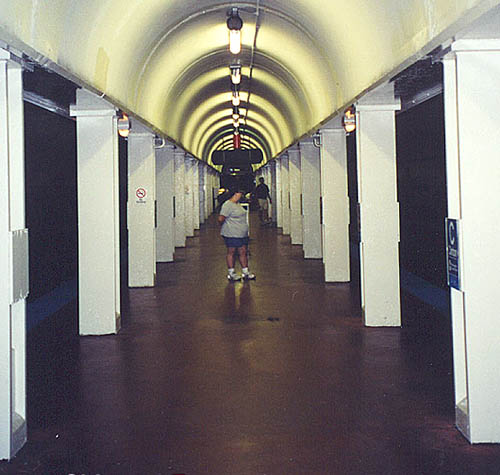
The island platform of
Clinton station is typical of those in the State Street and
Milwaukee-Dearborn subways, although Clinton was built 15
years after the former and 7 years after the latter. This
view looks east toward the exit in August, 2002. For a
larger view, click here.
(Photo by Andrew
Stiffler)
|

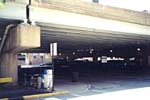
|
clinton01.jpg
(79k)
The entrances to Clinton station are located underneath the
Eisenhower Expressway viaduct over Clinton Street, as seen
looking southwest from the corner of Clinton and Tilden on
August 2, 2002. (Photo by Andrew
Stiffler)
|
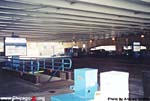
|
clinton02.jpg
(74k)
As seen in this August 2, 2002 view, the stairways down to
the Clinton subway mezzanine are typical of those built in
the 1940s and '50s for the other subway stations except that
they're not around an at-grade street intersection: they're
under the expressway viaduct. This arrangement makes them
somewhat hidden from view and less than ideal in terms of
customer appeal. (Photo by Andrew
Stiffler)
|
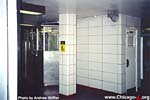
|
clinton03.jpg
(85k)
This small tiled enclosure in the unpaid area, seen looking
northwest on August 2, 2002, houses a toilet for the agent
(accessible from inside the booth) and a porter's closest
(accessible from the door on the right). The stainless steel
agent's booth is on the other side of the rooms, visible on
the left. (Photo by Andrew
Stiffler)
|

|
clinton04.jpg
(85k)
Several generations of signage adorn the walls of Clinton's
mezzanine on August 2, 2002. The lettering pointing
passengers to Union Station is original to the station,
inlaid in the glazed block and executed in the Futura-like
typeface used for the other subway stations. The Greyhound
sign below was added later when the bus terminal opened
nearby in the early 2000s. The station timetable is covered
with printed times as a makeshift solution to a new schedule
being in effect before new posters could be printed up and
mounted. (Photo by Andrew
Stiffler)
|
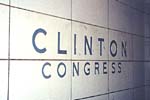
|
clinton05.jpg
(46k)
Like other stations in the Initial System of Subways lines,
Clinton's station name is inlaid in the glazed tile walls on
the island platform that surround the stairs and escalators
up to the mezzanine. As seen on August 2, 2002, the
lettering is the Futura variant typical of the early subways
and the blue color is consistent with the station's chosen
accent color. (Photo by Andrew
Stiffler)
|
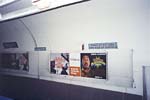
|
clinton07.jpg
(63k)
The tunnel walls at Clinton station, seen on August 2, 2002,
are an eclectic place indeed! The signage dates from over
several decades: the station name sign on the left follows
the KDR
standard and dates from the 1980s. Those in the middle and
on the right are original from the 1950s. Clinton's original
signs differed from the others on the Dearborn Subway in
having a blue background rather than gray, while the sign on
the right differs even more by having red lettering rather
than white (the only such original subway signs to have red
lettering on a colored background). The ad panels were added
in the modern era. (Photo by Andrew
Stiffler)
|
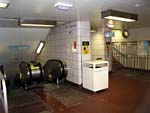
|
clinton09.jpg
(132k)
This December 7, 2001 view looks northwest in Clinton's paid
area at the vertical access from the mezzanine down to the
platform. As at LaSalle one stop to the east, a separate
stairway is provided to the right because two escalators
(one in each direction) are provided rather than one
escalator and a set of stairs side-by-side as at the
downtown stations. The signage with the blue background are
original to the station. (Photo by Graham
Garfield)
|

|
clinton_WBsign.jpg
(21k)
In the 1980s, when Clinton station received KDR-type
signage, the platform columns received these "symbol signs".
This sign contains several things that are now out-of-date,
including mention of A/B skip-stop service and the former
names of the two terminals (changed in the 1990s). Also seen
in this August 2, 2002 view is the attempt to paint over the
words "AB
Station", though most of it is scratched off. These
signs were scheduled to be replaced with Current
Graphic Standard versions in March 2004.
(Photo by Andrew Stiffler)
|
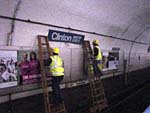
|
clinton10.jpg
(128k)
During a closure of the subway for the installation of
telecommunications lines, Facilities Maintenance personnel
prepare to remove the KDR-type
station name signs on the tunnel walls during the early
morning hours of March 7, 2004. (Photo by
Victor Ramirez)
|
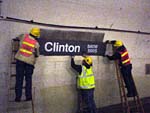
|
clinton11.jpg
(145k)
After removing the older KDR-type
station name sign, whose former location is outlined by
bare, unpainted rectangle on the concrete wall, Facilities
Maintenance personnel put up a new Current
Graphic Standards sign in the early morning hours of
March 7, 2004. The new sign is placed several inches lower
than the old one to adhere to Americans with Disabilities
Act standards. (Photo by Victor
Ramirez)
|
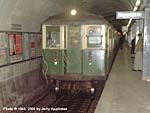
|
cta4000s11.jpg
(50k)
Shortly before their retirement, a center door-equipped
"Baldie" 4000-series
car leads a six-car train of like-equipment on an eastbound
Douglas-Milwaukee "B" train at Clinton/Congress station in
February 1964. The arrival of the 2000-series
cars and the assignment of 40 of them to the West-Northwest
Route allowed for the retirement of these
cars. (Photo by Jerry Appleman)
|
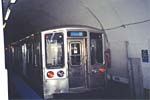
|
cta2224.jpg
(83k)
Car 2224 brings up the rear of a northbound Blue Line train
at Clinton during a midday run on August 2, 2002, at a time
of day when it is common to see 2200s
at the front or rear of trains. (Photo by
Andrew Stiffler)
|

- Clinton_Blue_next.wav
(114k): "Clinton is next. Doors open on the left at
Clinton." (Sound
courtesy of Tony Coppoletta)
.
- Clinton_Blue.wav
(38k): "This is Clinton"
(Sound courtesy of Tony Coppoletta)

















